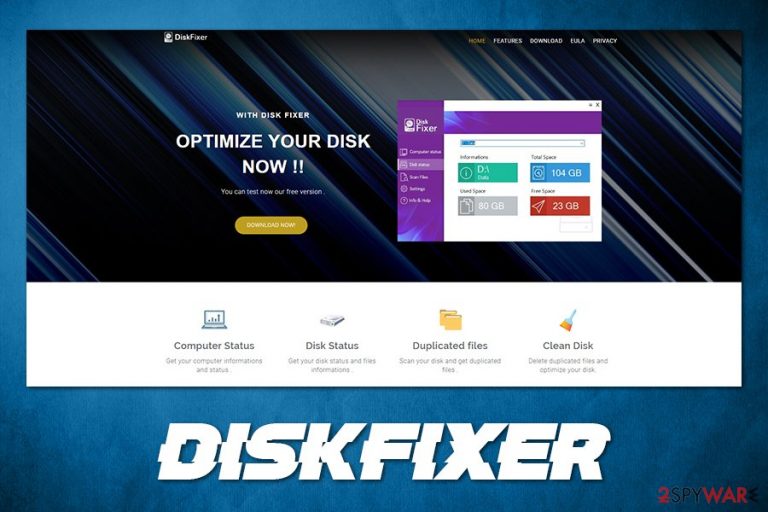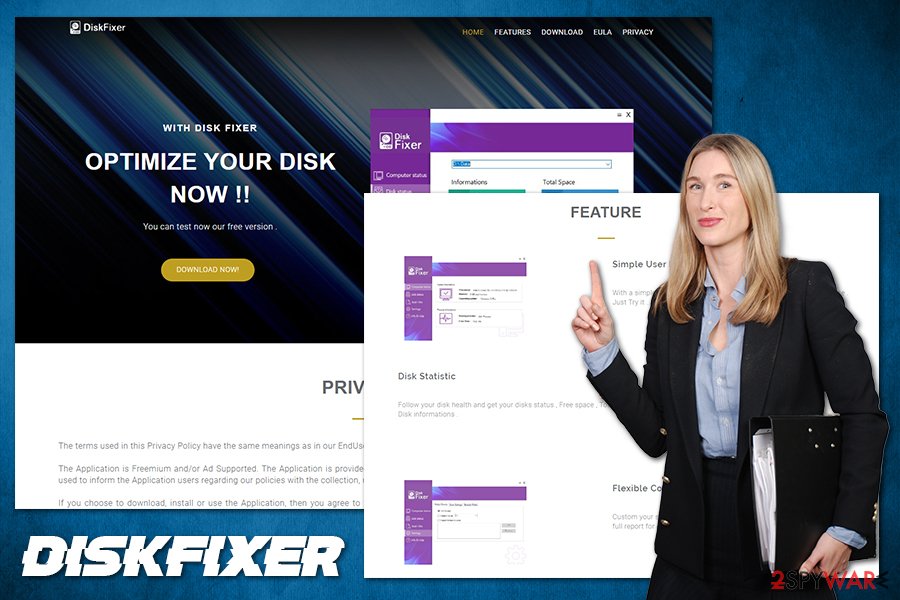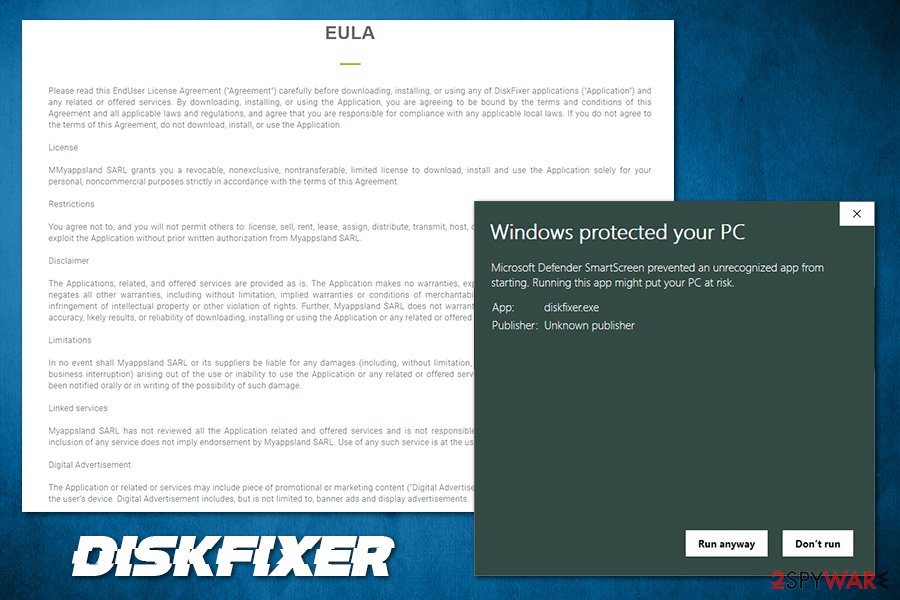DiskFixer (Easy Removal Guide) - Free Instructions
DiskFixer Removal Guide
What is DiskFixer?
DiskFixer – a fake system optimizer that is detected by multiple AV vendors

DiskFixer is a poorly designed application that can allegedly help users to optimize their Windows computers by the disk cleaning process and duplicated file removal. While such features may seem useful at first glance, it is important to note that the app typically gets installed without users' consent, displays false positives, and actively urges users to purchase a full version of the program, often showing DiskFixer ads an pop-ups.
Besides using dubious distribution and operation techniques, DiskFixer might not only fail to deliver what it promises but also compromise the computer by deleting necessary files on the system. This can significantly diminish computer performance instead of enhancing it, so security experts[1] highly recommend to remove DiskFixer from the machine as soon as possible and never purchase a full version of the app.
| Name | DiskFixer |
| Type | Potentially unwanted program, adware |
| Developer | Myappsland SARL |
| Operating system | Windows |
| Infiltration | While the app is available from its official website, most users install it unintentionally when downloading freeware from third-party sites or after they see an attractive advertisement |
| Alleged functionality | The app can allegedly display disk and file-related information, delete duplicates and optimize system performance |
| Dangers | Unreliable PC optimization tools can actually compromise its functions, resulting in a total reinstallation of Windows. Additionally, those who opt to purchase the app will suffer financial losses as the app does not benefit a computer in any way |
| Removal | To uninstall potentially unwanted programs, you can follow out manual guide below or employ anti-malware software to eliminate it for you |
| Recovery | Unreliable tools like DiskFixer could destroy files that are valuable to the operating system, compromising its performance. If you having troubles with Windows stability, repair it with FortectIntego |
While DiskFixer can be downloaded from the official website, users rarely install the app purposely. Just as many other potentially unwanted programs, it is distributed via software bundle packages. These typically include a freeware app and multiple optional components that are cleverly hidden within the installer. With the help of various deceptive methods, users are unable to spot the DiskFixer virus during the process, which results in the unsolicited installation of the app.
Developed by Myappsland SARL, DiskFixer is just one of many insecure applications that claim they can fix and optimize Windows computers. In reality, most of them use unfair distribution tactics, display fake results in order to make users purchase a full version of the app, show malicious ads, and simply scam users in various ways. Some of the best examples include:
- OneSafe PC Cleaner
- Registry Cleaner Pro
- System Optimizer
- Pro PC Cleaner
- PC Cleaner Pro, and many others
While DiskFixer is advertised as a tool with different functions, none of them are actually available before users purchase a full license of the software, although even after spending money on this useless app, users will still not gain any benefit. Besides, it is unknown what protection DiskFixer developers or its partners are using in order to protect the financial information entered during the purchase.
In the meantime, those who will keep DiskFixer installed on the system will be constantly nagged about a full version. Additionally, users might also see an increased amount of pop-ups, deals, offers, banners, coupons, in-text links, and other types of advertisements on Google Chrome, Mozilla Firefox, Internet Explorer, MS Edge, or another web browsers. DiskFixer ads might also be unsafe, so we highly discourage clicking on them.

Possibly the most dangerous trait of DiskFixer is actually within its functionality. In case you stumble upon a version that “works,” it might delete necessary files on your system. As a result, you might have to reinstall Windows altogether. In case that happened to you, use FortectIntego to repaid damage done to the OS.
Another reason for DiskFixer removal is its surveillance practices that should not be performed by system optimization tools in the first place. As explained in Privacy Policy of the app, various data is collected when users interact with it in one or another:
Whenever you download, install or use the Application or related or offered services. Myappsland SARL collects data and information (through third party products) called Tracking Data. These data may include information such as your device Internet Protocol (“IP”) address, device name, operating system version, the configuration of the Application, the time and date of your use of the Application or related or offered service, and other statistics.
Besides generic data, DiskFixer may also ask users to provide personal information for registration processes – it not only sores it on its servers but also shares it with certain third-parties.
Avoid getting tricked by fake system optimizers
As previously mentioned, all fake system optimization tools work in a very similar way. In fact, the scheme does not differ much from online scams, apart from the fact that users have a potentially malicious app installed on their computers. Usually, deceptive tools are marketed on a variety of websites and are often bundled with other software on third-party sites. As a result, users either do not notice the entry of the app or are tricked with promises of a faster and better PC.
Nonetheless, a very few of such programs deliver the promised functionality: they often flag harmless files like certain registry entries or Google's cookies and classify these items as a high threat to the PC, while in reality, these are legitimate files that are supposed to stay on the system in the first place. Removing them will not speed up a computer in any way. Likewise, the entries are often presented in a way that would make users alert – the red color is often used to associate the detection with danger or instability.
Due to a lack of IT skills, many users who are tricked into installing a deceptive app, start believing that they need to repair their machines, despite it being in good condition. Those who want to “fix” the found issues are redirected to a payment page, where they are asked to spend a substantial amount of money for the full license of the app. This is why fake optimizers are often called scareware/scamware[2] and have been extremely prevalent for many years now.
To avoid such scenarios, you should opt for official sources for your downloads. If that is not possible for you, you should pay close attention during the installation process of software, decline all the deals/offers, and always opt for Advanced/Custom installation settings. Also, make sure that the app is not shady after check its functions via blog posts, user reviews, articles, and similar methods.
DiskFixer uninstallation process
DiskFixer removal should not be too complicated for most of the users. Nonetheless, those who do not uninstall programs often might have difficulties. Therefore, we provided comprehensive instructions on how to manually uninstall the app via the Control Panel on Windows systems – check the instructions below. Additionally, because the DiskFixer virus might have placed cookies on your web browsers in order to track you, you might want to reset all the installed web browsers, although this is completely optional.

You can also attempt to remove DiskFixer with the help of a reputable anti-malware software that detects the app as a PUP. Simply download a security app on your PC, update it to the latest version, and perform a full system scan. Currently, there are several AVs that detect the app under the following names:[3]
- PUP.Optional.DiskFixer
- PUA:Win32/Presenoker
- BehavesLike.Win32.AdwareFileTour.gc
- W32.Adware.Gen
- Malicious.070bf2, etc.
You may remove virus damage with a help of FortectIntego. SpyHunter 5Combo Cleaner and Malwarebytes are recommended to detect potentially unwanted programs and viruses with all their files and registry entries that are related to them.
Getting rid of DiskFixer. Follow these steps
Uninstall from Windows
To uninstall DiskFixer from your computer, please follow these steps:
Instructions for Windows 10/8 machines:
- Enter Control Panel into Windows search box and hit Enter or click on the search result.
- Under Programs, select Uninstall a program.

- From the list, find the entry of the suspicious program.
- Right-click on the application and select Uninstall.
- If User Account Control shows up, click Yes.
- Wait till uninstallation process is complete and click OK.

If you are Windows 7/XP user, proceed with the following instructions:
- Click on Windows Start > Control Panel located on the right pane (if you are Windows XP user, click on Add/Remove Programs).
- In Control Panel, select Programs > Uninstall a program.

- Pick the unwanted application by clicking on it once.
- At the top, click Uninstall/Change.
- In the confirmation prompt, pick Yes.
- Click OK once the removal process is finished.
Remove from Microsoft Edge
Delete unwanted extensions from MS Edge:
- Select Menu (three horizontal dots at the top-right of the browser window) and pick Extensions.
- From the list, pick the extension and click on the Gear icon.
- Click on Uninstall at the bottom.

Clear cookies and other browser data:
- Click on the Menu (three horizontal dots at the top-right of the browser window) and select Privacy & security.
- Under Clear browsing data, pick Choose what to clear.
- Select everything (apart from passwords, although you might want to include Media licenses as well, if applicable) and click on Clear.

Restore new tab and homepage settings:
- Click the menu icon and choose Settings.
- Then find On startup section.
- Click Disable if you found any suspicious domain.
Reset MS Edge if the above steps did not work:
- Press on Ctrl + Shift + Esc to open Task Manager.
- Click on More details arrow at the bottom of the window.
- Select Details tab.
- Now scroll down and locate every entry with Microsoft Edge name in it. Right-click on each of them and select End Task to stop MS Edge from running.

If this solution failed to help you, you need to use an advanced Edge reset method. Note that you need to backup your data before proceeding.
- Find the following folder on your computer: C:\\Users\\%username%\\AppData\\Local\\Packages\\Microsoft.MicrosoftEdge_8wekyb3d8bbwe.
- Press Ctrl + A on your keyboard to select all folders.
- Right-click on them and pick Delete

- Now right-click on the Start button and pick Windows PowerShell (Admin).
- When the new window opens, copy and paste the following command, and then press Enter:
Get-AppXPackage -AllUsers -Name Microsoft.MicrosoftEdge | Foreach {Add-AppxPackage -DisableDevelopmentMode -Register “$($_.InstallLocation)\\AppXManifest.xml” -Verbose

Instructions for Chromium-based Edge
Delete extensions from MS Edge (Chromium):
- Open Edge and click select Settings > Extensions.
- Delete unwanted extensions by clicking Remove.

Clear cache and site data:
- Click on Menu and go to Settings.
- Select Privacy, search and services.
- Under Clear browsing data, pick Choose what to clear.
- Under Time range, pick All time.
- Select Clear now.

Reset Chromium-based MS Edge:
- Click on Menu and select Settings.
- On the left side, pick Reset settings.
- Select Restore settings to their default values.
- Confirm with Reset.

Remove from Mozilla Firefox (FF)
Remove dangerous extensions:
- Open Mozilla Firefox browser and click on the Menu (three horizontal lines at the top-right of the window).
- Select Add-ons.
- In here, select unwanted plugin and click Remove.

Reset the homepage:
- Click three horizontal lines at the top right corner to open the menu.
- Choose Options.
- Under Home options, enter your preferred site that will open every time you newly open the Mozilla Firefox.
Clear cookies and site data:
- Click Menu and pick Settings.
- Go to Privacy & Security section.
- Scroll down to locate Cookies and Site Data.
- Click on Clear Data…
- Select Cookies and Site Data, as well as Cached Web Content and press Clear.

Reset Mozilla Firefox
If clearing the browser as explained above did not help, reset Mozilla Firefox:
- Open Mozilla Firefox browser and click the Menu.
- Go to Help and then choose Troubleshooting Information.

- Under Give Firefox a tune up section, click on Refresh Firefox…
- Once the pop-up shows up, confirm the action by pressing on Refresh Firefox.

Remove from Google Chrome
After you eliminate the unwanted app, you can also reset Google Chrome in order to get rid of the cookies and other unwanted settings:
Delete malicious extensions from Google Chrome:
- Open Google Chrome, click on the Menu (three vertical dots at the top-right corner) and select More tools > Extensions.
- In the newly opened window, you will see all the installed extensions. Uninstall all the suspicious plugins that might be related to the unwanted program by clicking Remove.

Clear cache and web data from Chrome:
- Click on Menu and pick Settings.
- Under Privacy and security, select Clear browsing data.
- Select Browsing history, Cookies and other site data, as well as Cached images and files.
- Click Clear data.

Change your homepage:
- Click menu and choose Settings.
- Look for a suspicious site in the On startup section.
- Click on Open a specific or set of pages and click on three dots to find the Remove option.
Reset Google Chrome:
If the previous methods did not help you, reset Google Chrome to eliminate all the unwanted components:
- Click on Menu and select Settings.
- In the Settings, scroll down and click Advanced.
- Scroll down and locate Reset and clean up section.
- Now click Restore settings to their original defaults.
- Confirm with Reset settings.

Delete from Safari
Remove unwanted extensions from Safari:
- Click Safari > Preferences…
- In the new window, pick Extensions.
- Select the unwanted extension and select Uninstall.

Clear cookies and other website data from Safari:
- Click Safari > Clear History…
- From the drop-down menu under Clear, pick all history.
- Confirm with Clear History.

Reset Safari if the above-mentioned steps did not help you:
- Click Safari > Preferences…
- Go to Advanced tab.
- Tick the Show Develop menu in menu bar.
- From the menu bar, click Develop, and then select Empty Caches.

After uninstalling this potentially unwanted program (PUP) and fixing each of your web browsers, we recommend you to scan your PC system with a reputable anti-spyware. This will help you to get rid of DiskFixer registry traces and will also identify related parasites or possible malware infections on your computer. For that you can use our top-rated malware remover: FortectIntego, SpyHunter 5Combo Cleaner or Malwarebytes.
How to prevent from getting adware
Protect your privacy – employ a VPN
There are several ways how to make your online time more private – you can access an incognito tab. However, there is no secret that even in this mode, you are tracked for advertising purposes. There is a way to add an extra layer of protection and create a completely anonymous web browsing practice with the help of Private Internet Access VPN. This software reroutes traffic through different servers, thus leaving your IP address and geolocation in disguise. Besides, it is based on a strict no-log policy, meaning that no data will be recorded, leaked, and available for both first and third parties. The combination of a secure web browser and Private Internet Access VPN will let you browse the Internet without a feeling of being spied or targeted by criminals.
No backups? No problem. Use a data recovery tool
If you wonder how data loss can occur, you should not look any further for answers – human errors, malware attacks, hardware failures, power cuts, natural disasters, or even simple negligence. In some cases, lost files are extremely important, and many straight out panic when such an unfortunate course of events happen. Due to this, you should always ensure that you prepare proper data backups on a regular basis.
If you were caught by surprise and did not have any backups to restore your files from, not everything is lost. Data Recovery Pro is one of the leading file recovery solutions you can find on the market – it is likely to restore even lost emails or data located on an external device.
- ^ Lesvirus. Lesvirus. Security advice and malware insights.
- ^ What is Scareware?. Forcepoint. Security blog.
- ^ f384c7ce84f7784c5a8a4612f440fa2ee797c669129ffe0ce2fc89062bf7a2c8. Virus Total. File and URL analysis.
